
| Previous Part | Main Index | Next Part |


This volume, as its title indicates, is a collection of engravings illustrative of the Bible—the designs being all from the pencil of the greatest of modern delineators, Gustave Dore. The original work, from which this collection has been made, met with an immediate and warm recognition and acceptance among those whose means admitted of its purchase, and its popularity has in no wise diminished since its first publication, but has even extended to those who could only enjoy it casually, or in fragmentary parts. That work, however, in its entirety, was far too costly for the larger and ever-widening circle of M. Dore's admirers, and to meet the felt and often-expressed want of this class, and to provide a volume of choice and valuable designs upon sacred subjects for art-loving Biblical students generally, this work was projected and has been carried forward. The aim has been to introduce subjects of general interest—that is, those relating to the most prominent events and personages of Scripture—those most familiar to all readers; the plates being chosen with special reference to the known taste of the American people. To each cut is prefixed a page of letter-press—in, narrative form, and containing generally a brief analysis of the design. Aside from the labors of the editor and publishers, the work, while in progress, was under the pains-taking and careful scrutiny of artists and scholars not directly interested in the undertaking, but still having a generous solicitude for its success. It is hoped, therefore, that its general plan and execution will render it acceptable both to the appreciative and friendly patrons of the great artist, and to those who would wish to possess such a work solely as a choice collection of illustrations upon sacred themes.
The subject of this sketch is, perhaps, the most original and variously gifted designer the world has ever known. At an age when most men have scarcely passed their novitiate in art, and are still under the direction and discipline of their masters and the schools, he had won a brilliant reputation, and readers and scholars everywhere were gazing on his work with ever-increasing wonder and delight at his fine fancy and multifarious gifts. He has raised illustrative art to a dignity and importance before unknown, and has developed capacities for the pencil before unsuspected. He has laid all subjects tribute to his genius, explored and embellished fields hitherto lying waste, and opened new and shining paths and vistas where none before had trod. To the works of the great he has added the lustre of his genius, bringing their beauties into clearer view and warming them to a fuller life.
His delineations of character, in the different phases of life, from the horrible to the grotesque, the grand to the comic, attest the versatility of his powers; and, whatever faults may be found by critics, the public will heartily render their quota of admiration to his magic touch, his rich and facile rendering of almost every thought that stirs, or lies yet dormant, in the human heart. It is useless to attempt a sketch of his various beauties; those who would know them best must seek them in the treasure—house that his genius is constantly augmenting with fresh gems and wealth. To one, however, of his most prominent traits we will refer—his wonderful rendering of the powers of Nature.
His early wanderings in the wild and romantic passes of the Vosges doubtless developed this inherent tendency of his mind. There he wandered, and there, mayhap, imbibed that deep delight of wood and valley, mountain—pass and rich ravine, whose variety of form and detail seems endless to the enchanted eye. He has caught the very spell of the wilderness; she has laid her hand upon him, and he has gone forth with her blessing. So bold and truthful and minute are his countless representations of forest scenery; so delicate the tracery of branch and stem; so patriarchal the giant boles of his woodland monarchs, that the' gazer is at once satisfied and entranced. His vistas lie slumbering with repose either in shadowy glade or fell ravine, either with glint of lake or the glad, long course of some rejoicing stream, and above all, supreme in a beauty all its own, he spreads a canopy of peerless sky, or a wilderness, perhaps, of angry storm, or peaceful stretches of soft, fleecy cloud, or heavens serene and fair—another kingdom to his teeming art, after the earth has rendered all her gifts.
Paul Gustave Dore was born in the city of Strasburg, January 10, 1833. Of his boyhood we have no very particular account. At eleven years of age, however, he essayed his first artistic creation—a set' of lithographs, published in his native city. The following year found him in Paris, entered as a 7. student at the Charlemagne Lyceum. His first actual work began in 1848, when his fine series of sketches, the "Labors of Hercules," was given to the public through the medium of an illustrated, journal with which he was for a long time connected as designer. In 1856 were published the illustrations for Balzac's "Contes Drolatiques" and those for "The Wandering Jew "—the first humorous and grotesque in the highest degree—indeed, showing a perfect abandonment to fancy; the other weird and supernatural, with fierce battles, shipwrecks, turbulent mobs, and nature in her most forbidding and terrible aspects. Every incident or suggestion that could possibly make the story more effective, or add to the horror of the scenes was seized upon and portrayed with wonderful power. These at once gave the young designer a great reputation, which was still more enhanced by his subsequent works.
With all his love for nature and his power of interpreting her in her varying moods, Dore was a dreamer, and many of his finest achievements were in the realm of the imagination. But he was at home in the actual world also, as witness his designs for "Atala," "London—a Pilgrimage," and many of the scenes in "Don Quixote."
When account is taken of the variety of his designs, and the fact considered that in almost every task he attempted none had ventured before him, the amount of work he accomplished is fairly incredible. To enumerate the immense tasks he undertook—some single volumes alone containing hundreds of illustrations—will give some faint idea of his industry. Besides those already mentioned are Montaigne, Dante, the Bible, Milton, Rabelais, Tennyson's "Idyls of the King," "The Ancient Mariner, Shakespeare, "Legende de Croquemitaine," La Fontaine's "Fables," and others still.
Take one of these works—the Dante, La Fontaine, or "Don Quixote"—and glance at the pictures. The mere hand labor involved in their production is surprising; but when the quality of the work is properly estimated, what he accomplished seems prodigious. No particular mention need be made of him as painter or sculptor, for his reputation rests solely upon his work as an illustrator.
Dore's nature was exuberant and buoyant, and he was youthful in appearance. He had a passion for music, possessed rare skill as a violinist, and it is assumed that, had he failed to succeed with his pencil, he could have won a brilliant reputation as a musician.
He was a bachelor, and lived a quiet, retired life with his mother—married, as he expressed it, to her and his art. His death occurred on January 23, 1883.
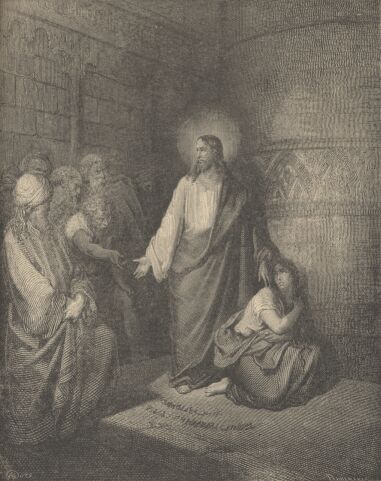
Jesus went unto the mount of Olives. And early in the morning he came again into the temple, and all the people came unto him; and he sat down, and taught them.
And the scribes and Pharisees brought unto him a woman taken in adultery; and when they had set her in the midst, they say unto him, Master, this woman was taken in adultery, in the very act. Now Moses in the law commanded us, that such should be stoned: but what sayest thou? This they said, tempting him, that they might have to accuse him.
But Jesus stooped down, and with his finger wrote on the ground, as though he heard them not.
So when they continued asking him, he lifted up himself, and said unto them, He that is without sin among you, let him first cast a stone at her.
And again he stooped down, and wrote on the ground.
And they which heard it, being convicted by their own conscience, went out one by one, beginning at the eldest, even unto the last; and Jesus was left alone, and the woman standing in the midst. When Jesus had lifted up himself, and saw none but the woman, he said unto her, Woman where are those thine accusers? Hath no man condemned thee? She said, No man, Lord.
And Jesus said unto her, Neither do I condemn thee: go, and sin no more. —john viii, 1-11

Now Jesus was not yet come into the town, but was in that place where Martha met him. The Jews then which were with her in the house, and comforted her, when they saw Mary, that she rose up hastily and went out, followed her, saying, She goeth unto the grave to weep there. Then when Mary was come where Jesus was, and saw him, she fell down at his feet, saying unto him, Lord, if thou hadst been here, my brother had not died.
When Jesus therefore saw her weeping, and the Jews also weeping which came with her, he groaned in the spirit, and was troubled, and said, Where have ye laid him?
They said unto him, Lord, come and see.
Jesus wept.
Then said the Jews, Behold how he loved him! And some of them said, Could not this man, which opened the eyes of the blind, have caused that even this man should not have died?
Jesus therefore again groaning in himself cometh to the grave. It was a cave and a stone lay upon it. Jesus said, Take ye away the stone.
Martha, the sister of him that was dead, saith unto him, Lord, by this time he stinketh for he hath been dead four days.
Jesus saith unto her, Said I not unto thee, that, if thou wouldest believe, thou shouldest see the glory of God?
Then they took away the stone from the place where the dead was laid.
And Jesus lifted up his eyes, and said, Father, I thank thee that thou hast heard me. And I knew that thou hearest me always: but because of the people which stand by I said it, that they may believe that thou hast sent me.
And when he thus had spoken, he cried with a loud voice, Lazarus, come forth.
And he that was dead came forth, bound hand and foot with graveclothes: and his face was bound about with a napkin.
Jesus saith unto them, Loose him, and let him go.
Then many of the Jews which came to Mary, and had seen the things which Jesus did, believed on him.—John xi, 30-45
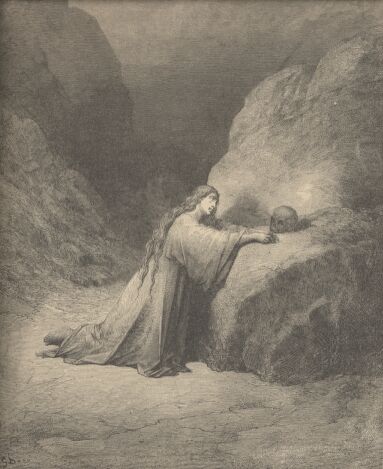
Of Mary "called Magdalene" (Luke viii, 2) but few particulars are recorded in scripture. We first hear of her as having been delivered by Jesus of seven devils (Luke viii, 1-3; Mark xvi, 9). Impelled, no doubt, by gratitude for her deliverance, she becomes one of his followers, accompanying him thenceforward in all his wanderings faithfully till his death. She was the first person to whom he appeared after his resurrection (Mark xvi, 9; John xx, 1, 11-18) The common belief that she was a fallen woman is destitute of the slightest foundation. On the contrary, the references to her as being in the company of such women as Joanna, the wife of Herod's steward, Salome, the mother of James and John, and Mary, the mother of Jesus (Luke viii, 3; Mark xvi, 40; John xix, 25), strongly discountenance such a supposition. The error, which had no other source than ecclesiastical tradition, has been fostered and perpetuated by the stupid blunder of the translators of the authorized version in identifying her with the "sinner" who is described in Luke vii, 37-50 as washing the feet of Jesus with her tears (see head-note to Luke vii).
The Roman Catholic notion that this "sinner" was Mary the sister of Lazarus is almost equally groundless (see Douay Bible, head-note to Matthew xxvi, and the foot-note references to Luke vii, 37, found in most Catholic Bibles). The only reason for this identification is that the anointing by the "sinner" is described as taking place in the house of a Pharisee named Simon (Luke vii, 36, 39-40 43-44); that the anointing by the unnamed woman, as described in Matthew xxvi, 6-13 and Mark xiv, 3-9, took place in the house of one "Simon the leper," in Bethany; and that Mary, the sister of Lazarus, is described in John xi, 2, and xii, 3-8, as anointing Jesus in a house (apparently that of Lazarus himself) in Bethany, when a conversation ensues altogether different from that recorded in Luke vii, but similar to that related in Matthew xxvi, and Mark xiv, save that the objection to the anointing of Jesus is made, not by "his disciples" (Matthew xxvi, 8), not by "some that had indignation" (Mark xiv, 4), but by "one of his disciples, Judas Iscariot, Simon's son" (John xii, 4). The demeanor of Mary, the sister of Lazarus, is, however, by no means that of a fallen and sinful though penitent woman but that of a pious and good one (see Luke x, 39, 42; John xi, 28-33; xii, 3).
Dore's illustration, which portrays Mary Magdalene as a heartbroken and despairing sinner, shows that he has fallen into the common error.
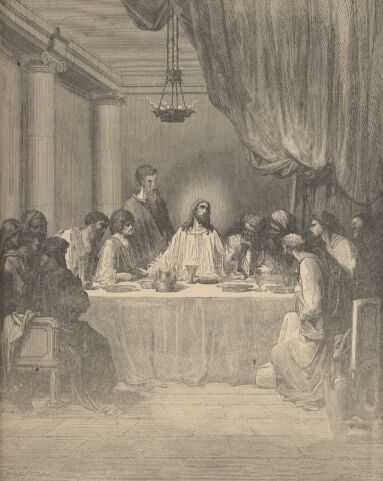
Now the first day of the feast of unleavened bread the disciples came to Jesus, saying unto him, Where wilt thou that we prepare for thee to eat the passover? And he said, Go into the city to such a man, and say unto him, The Master saith, My time is at hand; I will keep the passover at thy house with my disciples. And the disciples did as Jesus had appointed them; and they made ready the passover.
Now when the even was come, he sat down with the twelve. And as they did eat, he said, Verily I say unto you, that one of you shall betray me.
And they were exceeding sorrowful, and began every one of them to say unto him, Lord, is it I?
And he answered and said, He that dippeth his hand with me in the dish, the same shall betray me. The Son of man goeth as it is written of him: but woe unto that man by whom the Son of man is betrayed! it had been good for that man if he had not been born. Then Judas, which betrayed him, answered and said, Master, is it I? He said unto him, Thou hast said.
And as they were eating, Jesus took bread, and blessed it, and brake it, and gave it to the disciples, and said, Take, eat; this is my body. And he took the cup, and gave thanks, and gave it to them, saying, Drink ye all of it; for this is my blood of the new testament, which is shed for many for the remission of sins. But I say unto you, I will not drink henceforth of this fruit of the vine, until that day when I drink it new with you in my Father's kingdom.
And when they had sung an hymn, they went out into the mount of Olives.—Matthew xxvi, 17-30.
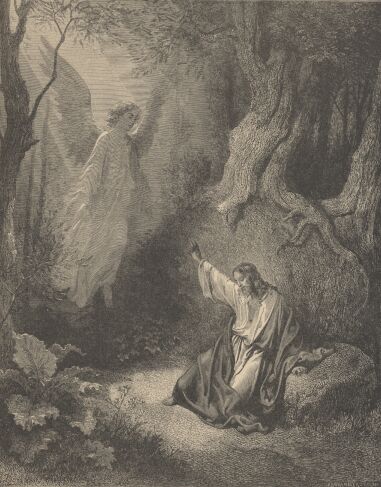
And he came out, and went, as he was wont, to the mount of Olives; and his disciples all followed him. And when he was at the place, he said unto them, Pray that ye enter not in temptation.
And he was withdrawn from them about a stone's cast, and kneeled down, and prayed Saying, Father, if thou be willing, remove this cup from me: nevertheless not my will, but thine, be done.
And there appeared an angel unto him from heaven, strengthening him.
And being in an agony he prayed more earnestly: and his sweat was as it were great drops, of blood falling down to the ground.
And when he rose up from prayer, and was come to his disciples, he found them sleeping for sorrow, and said unto them, Why sleep ye? rise and pray, lest ye enter into temptation—Luke xxii, 39-46.
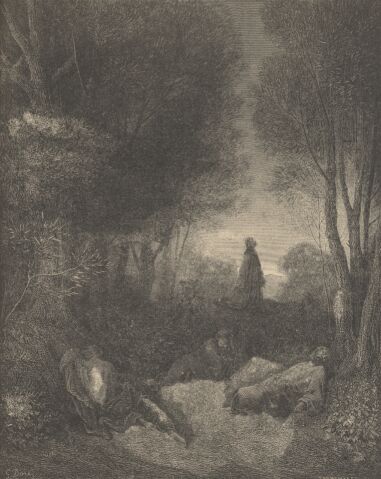
Then cometh Jesus with them unto a place called Gethsemane, and saith unto, the disciples, Sit ye here, while I go and pray yonder. And he took with him Peter and the two sons of Zebedee, and began to be sorrowful and very heavy. Then saith he unto them, My soul is exceeding sorrowful, even unto death: tarry ye here, and watch with me.
And he went a little farther, and fell on his face, and prayed, saying, O my Father, if be possible, let this cup pass from me: nevertheless not as I will, but as thou wilt.
And he cometh unto the disciples, and findeth them asleep, and saith unto Peter, What, could ye not watch with me one hour? Watch and pray, that ye enter not into temptation the spirit indeed is willing, but the flesh is weak.
He went away again the second time, and prayed, saying, O my Father, if this cup may not pass away from me, except I drink it, thy will be done.
And he came and found them asleep again: for their eyes were heavy.
And he left them, and went away again, and prayed the third time, saying the same words.
Then cometh he to his disciples, and saith unto them, Sleep on now, and take your rest behold, the hour is at hand, and the Son of man is betrayed into the hands of sinners. Rise let us be going: behold, he is at hand that doth betray me. Matthew xxvi, 36-46
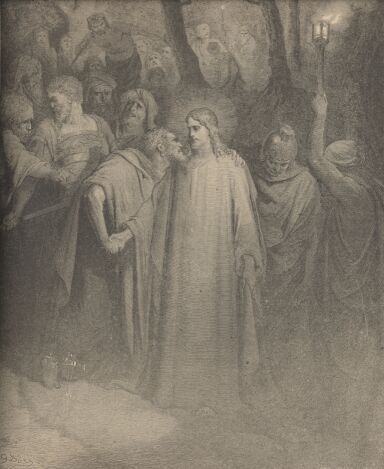
And he cometh the third time, and saith unto them, Sleep on now, and take your rest it is enough, the hour is come; behold, the Son of man is betrayed into the hands of sinners. Rise up, let us go; lo, he that betrayeth me is at hand.
And immediately, while he yet spake, cometh Judas, one of the twelve, and with him great multitude with swords and staves, from the chief priests and the scribes and the elders. And he that betrayed him had given them a token, saying, Whomsoever I shall kiss, that same is he; take him, and lead him away safely. And as soon as he was come, he goeth straight way to him, and saith, Master, master; and kissed him.
And they laid their hands on him, and took him. And one of them that stood by drew a sword, and smote a servant of the high priest, and cut off his ear. And Jesus answered and said unto them, Are ye come out, as against a thief, with swords and with staves to take me? I was daily with you in the temple teaching, and ye took me not but the scriptures must be fulfilled.
And they all forsook him, and fled.—Mark xiv, 41-50.
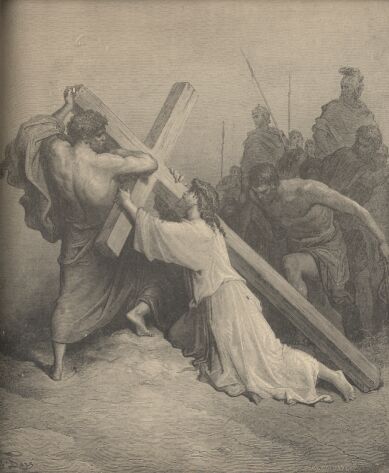
The incident depicted in this illustration seems to be as apocryphal as that embodied in the artist's picture of Mary Magdalene. There is absolutely no warrant in scripture for the notion that Christ fainted under the burden of the cross. The only foundation for such an idea to found in the Bible is contained in the head note to Mark xv, which is quite unwarranted by the text. According to the three synoptic gospels the cross was borne not by Christ, but by Simon, a Cyrenian (see Matthew xxvii, 32; Mark xv, 2 1; Luke xxiii, 26). According to the fourth evangelist, Jesus bore the cross without assistance the whole distance to the place crucifixion (John xix, 16-18). In not one of the four narratives is there so much as a hint that he fainted under the burden.
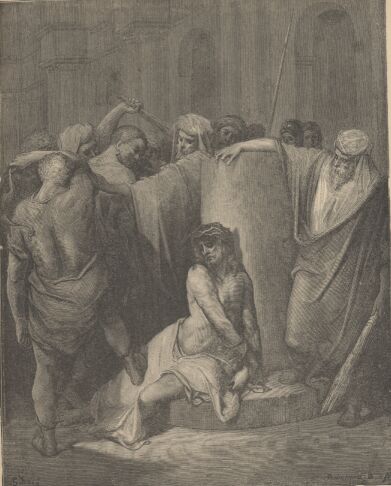
Then released he Barabbas unto them: and when he had scourged Jesus, he deliver him to be crucified.—Matthew xxvii, 26.
And so Pilate, willing to content the people, released Barabbas unto them, and deliver Jesus, when he had scourged him, to be crucified.—Mark xv, 15.
Then Pilate therefore took Jesus, and scourged him. John xix.
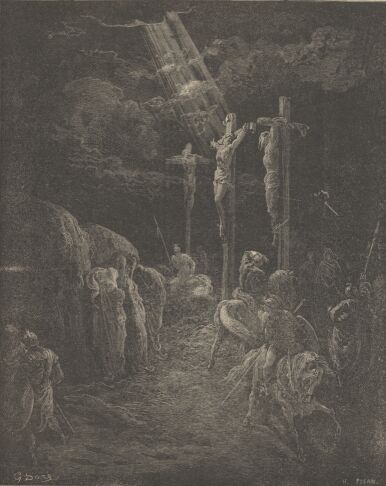
And when they were come unto a place called Golgotha, that is to say, a place of a skull they gave him vinegar to drink mingled with gall: and when he had tasted thereof, he would not drink. And they crucified him, and parted his garments, casting lots: that it might be fulfilled which was spoken by the prophet, They parted my garments among them, and upon my vesture did they cast lots. And sitting down they watched him there; and set up over his head his accusation written, THIS IS JESUS THE KING OF THE JEWS.
Then were there two thieves crucified with him, one on the right hand, and another on the left.
And they that passed by reviled him, wagging their heads, and saying, Thou that destroyest the temple, and buildest it in three days, save thyself. If thou be the Son of God come down from the cross.
Likewise also the chief priests mocking him, with the scribes and elders, said, He saved others: himself he cannot save. If he be the King of Israel, let him now come down from the cross, and we will believe him. He trusted in God; let him deliver him now, if he will have him: for he said, I am the Son of God.
The thieves also, which were crucified with him, cast the same in his teeth.—Matthew xxvii, 33—44.
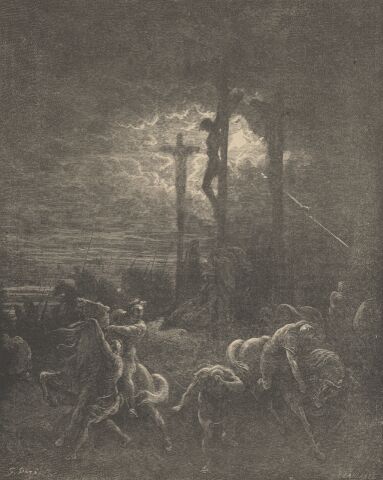
Now from the sixth hour there was darkness over all the land unto the ninth hour. And about the ninth hour Jesus cried with a loud voice, saying, Eli, Eli, lama sabachthani? that is to say, My God, my God, why hast thou forsaken me?
Some of them that stood there, when they heard that, said, This man calleth for Elias. And straightway one of them ran, and took a sponge, and filled it with vinegar, and put it on a reed, and gave him to drink. The rest said, Let be, let us see whether Elias will come to save him.
Jesus, when he had cried again with a loud voice, yielded up the ghost.
And, behold, the veil of the temple was rent in twain from the top to the bottom; and the earth did quake, and the rocks rent; and the graves were opened; and many bodies of the saints which slept arose, and came out of the graves after his resurrection, and went into the holy city, and appeared unto many.
Now when the centurion, and they that were with him, watching Jesus, saw the earthquake, and those things that were done, they feared greatly, saying, Truly this was the Son of God.
And many women were there beholding afar off, which followed Jesus from Galilee, ministering unto him: among which was Mary Magdalene, and Mary the mother of James and Joses, and the mother of Zebedee's children.—Matthew xxvii, 45-56.
| Previous Part | Main Index | Next Part |